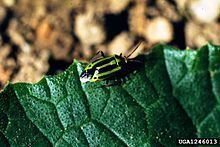Rank Species | ||
 | ||
Similar True bugs, Tarnished plant bug, Cosmopepla lintneriana, Mirini, Adelphocoris rapidus | ||
Poecilocapsus lineatus also known as Fourlined Plant Bug, is a species of bugs from Miridae family that are native to the United States.
Contents
Description
The adults are about 7–7.5 millimetres (0.28–0.30 in) in length and 3.5 millimetres (0.14 in) in width. Adults have four distinct black lines against a background color ranging from green to yellow, with an orange head and prominent, dark red eyes. Nymphs grow rapidly through five instars, with wing pads growing at each molt. Nymphs are a bright red color with black markings, except for the last instar which is bright orange.
Ecology
The species can be found on all kinds of plants, including wild Hydrangea and various shrubs. The shrub variety for these species is diverse, it can range from forsythia to sumac. They feed on different perennials, and vegetables. Both larvae and adults feed on leaves creating the translucent patches of leaf tissues that may later fall out to produce tiny holes. The nymphs cause the majority of plant damage.
Life cycle
The species has only one generation per year. They overwinter in the egg stage, hatching in mid to late spring. Both sexes mate within six weeks after birth. The egg hatch and development varies. In southern Pennsylvania, for example, the eggs hatched from mid to late April, with adults being seen by late May. While in the northern part of the same state, the development was 1–3 weeks later. Same goes with Indiana, where in the city of Lafayette the development was 2–3 weeks earlier, then in Itaca, New York.
Pest
The insect considers to be a pest, since the species occasionally do damage to herbaceous plants, mints, and rarely wood. The species damages plants from late spring to early summer.
